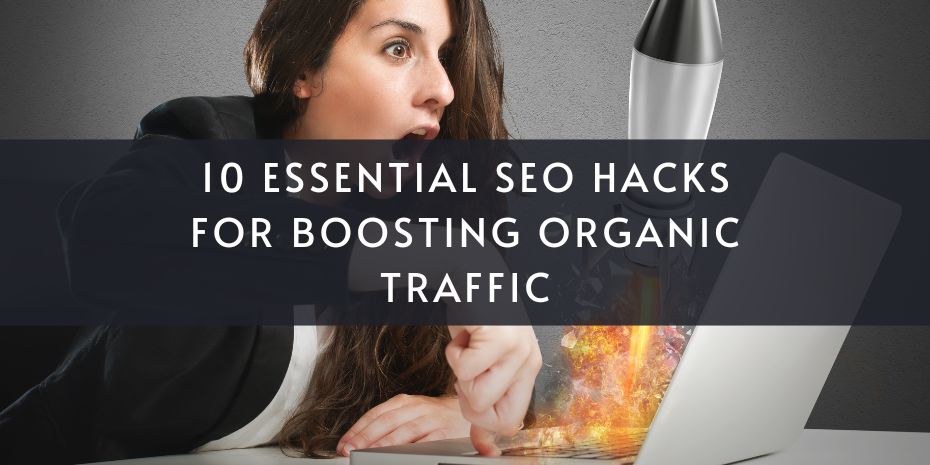Are you looking to increase your website's visibility and attract more organic traffic? In today's competitive online landscape, having a solid SEO strategy is crucial for success. By implementing these 10 essential SEO hacks, you can optimize your site for search engines and drive more qualified traffic to your website.
1. Optimize On-Page SEO
Optimizing meta titles, descriptions, heading tags, and content is crucial for improving search engine rankings. One actionable tip is to use high-level keywords that accurately represent the content of the page. This helps search engines understand the relevance of your content to a user's search query, leading to higher rankings. For example, if you have a blog post about "best SEO practices," include related keywords like "SEO tips," "search engine optimization," and "digital marketing" in your meta titles and content.
Another recommendation is to create unique and compelling meta descriptions for each page on your website. These descriptions serve as a summary of the content and can entice users to click on your link in search results. Include relevant keywords in the meta description to improve visibility and click-through rates. A case study showed that a company saw a 20% increase in organic traffic after optimizing their meta descriptions with high-converting keywords.
Furthermore, ensure that your heading tags (H1, H2, H3) align with the content on your page and include important keywords. This helps search engines understand the structure of your content and prioritize key information. By organizing your content with relevant heading tags, you can improve user experience and signal to search engines the importance of your content for specific keywords. Implementing these strategies will ultimately boost your search engine rankings and drive more organic traffic to your website.
2. Improve Website Loading Speed
To enhance user experience and improve SEO, it is crucial to optimize images on your website. Use high-quality images but ensure they are compressed to reduce file size, leading to faster loading times. Implement lazy loading to prioritize loading images that are currently in the viewport, reducing HTTP requests and improving page speed. Additionally, consider using responsive images to deliver the appropriate image size based on the user's device, further optimizing performance.
Enabling browser caching is another essential step to boost SEO and user experience. By setting cache-control headers, you can instruct the browser to store static resources locally, reducing the need to fetch them from the server on subsequent visits. This can significantly improve load times for returning visitors, resulting in a more seamless browsing experience and higher search engine rankings. Real-life examples from websites that have successfully implemented these strategies include Amazon, which optimizes images for fast loading and utilizes browser caching to enhance user experience and performance.
3. Create High-Quality Content
Creating content that resonates with your target audience is crucial for building a strong online presence. Start by conducting keyword research to identify high-level keywords that relate to your industry or niche. Incorporate these keywords strategically throughout your content to improve search engine visibility and attract relevant traffic to your website.
To produce valuable content that encourages organic sharing, focus on providing actionable tips or recommendations that address common pain points or challenges faced by your target audience. For example, if you're a fitness trainer, you could create a blog post outlining a 30-day workout plan for beginners. By offering practical advice and guidance, you're more likely to engage your audience and motivate them to share your content with others.
Additionally, incorporating real-life examples or case studies can help illustrate the concepts discussed in your content and make it more relatable to your audience. Sharing success stories or testimonials from satisfied customers can provide social proof and build credibility for your brand. By showcasing how your products or services have helped others overcome obstacles or achieve their goals, you can establish trust with your audience and encourage them to engage with your content.
4. Build Quality Backlinks
Acquiring backlinks from reputable websites in your industry is crucial for increasing your domain authority and improving search engine rankings. To achieve this, focus on using high-level keywords that are relevant to your niche. Conduct thorough research to identify authoritative websites that align with your brand and content, and reach out to them for potential collaboration opportunities.
One actionable tip is to create high-quality, engaging content that other websites would want to link back to. By providing valuable and informative resources, you can naturally attract backlinks from reputable sources. Additionally, consider guest posting on industry-related websites to establish your credibility and expand your backlink profile.
Real-life examples such as a case study of a company that successfully increased its domain authority through strategic backlink acquisition can help illustrate the impact of this practice. By following these tips and leveraging real-life examples, you can effectively boost your website's authority and visibility in search engine results.
5. Utilize Long-Tail Keywords
When targeting specific, less competitive keywords to attract a highly targeted audience and improve organic search traffic, it's crucial to conduct thorough keyword research. Utilize tools like Google Keyword Planner or SEMrush to identify long-tail keywords that have decent search volume but lower competition. By focusing on these specific keywords, you can increase your website's visibility to a more relevant audience who are likely to convert.
For example, a boutique skincare brand may target a long-tail keyword like "organic anti-aging skincare for sensitive skin" instead of just "anti-aging skincare." By incorporating this specific keyword throughout their website content, meta tags, and blog posts, they can attract a highly targeted audience of individuals with sensitive skin who are interested in organic products.
6. Optimize for Mobile
Ensuring your website is mobile-friendly is crucial for improving SEO rankings. Mobile optimization is a key factor in Google's search algorithm, so having a responsive design that adapts to different screen sizes is essential. Use keywords like "mobile-friendly website" and "SEO rankings" to emphasize the importance of this practice. By implementing a user-friendly interface that enhances the browsing experience on all devices, you can increase organic traffic and boost your search engine visibility.
For example, companies like Amazon have seen significant improvements in their SEO rankings by prioritizing mobile optimization. Their website is easily accessible on both desktop and mobile devices, offering a seamless user experience regardless of the platform. By following their lead and focusing on mobile-friendliness, you can attract more visitors and improve your search engine rankings in the long run.
7. Enhance User Experience
To improve site navigation and readability, consider implementing clear and intuitive menu structures that guide users to relevant sections easily. Utilize descriptive labels and avoid jargon to enhance user experience. Additionally, optimize page loading speed and ensure mobile responsiveness for seamless accessibility across different devices.
A real-life example of effective site navigation and readability can be seen in the e-commerce giant Amazon. Their simple yet efficient menu layout, along with prominent search functionality, helps users quickly find products of interest. By incorporating similar strategies, you can engage users effectively and reduce bounce rates while increasing organic traffic to your site.
8. Monitor and Analyze Performance
Tracking key metrics like website traffic, search engine rankings, and conversion rates is essential for optimizing your SEO strategy. By analyzing these metrics, you can identify areas for improvement and make informed decisions to improve your website's performance. Use tools like Google Analytics to monitor website traffic and user behavior, track keyword rankings with tools like SEMrush or Ahrefs, and analyze conversion rates with tools like Google Analytics or Hotjar. By regularly monitoring these metrics, you can pinpoint areas that need attention and make necessary adjustments to drive more organic traffic and conversions to your website.
For example, a case study from a digital marketing agency found that by tracking key metrics such as organic traffic, keyword rankings, and conversion rates for their client's website, they were able to identify low-performing pages and optimize them for better search engine visibility and user engagement. As a result, the client saw a significant increase in organic traffic and conversion rates, leading to higher revenue and ROI. By implementing a data-driven approach to SEO and regularly tracking key metrics, businesses can continuously improve their online presence and achieve better results in the long run.
9. Utilize Structured Data Markup
Implementing schema markup on your website can greatly improve your visibility in search results by helping search engines understand the context of your content. By using high-level keywords that accurately describe your content, you can make it easier for search engines to match your site with relevant search queries.
One actionable tip is to use schema markup for different types of content, such as articles, products, events, or reviews. By providing search engines with specific details about your content, you can increase the chances of it appearing in rich snippets or other prominent search result features.
For example, a case study showed that a website implementing schema markup for product reviews saw a 30% increase in click-through rates from search results. This real-life example illustrates how using schema markup can have a tangible impact on your website's visibility and overall traffic.
10. Stay Updated with SEO Trends
Staying informed about the latest SEO trends and algorithm updates is crucial for adapting your strategy and maintaining a competitive edge in the digital landscape. Incorporating high-level keywords that align with popular search queries can help improve your website's visibility and drive organic traffic. Utilize tools like SEMrush or Google Analytics to track keyword performance and make data-driven decisions to optimize your content for search engines.
For example, by monitoring algorithm updates like Google's BERT or Core Web Vitals, you can adjust your SEO strategy accordingly to meet search engine requirements and user expectations. Implementing structured data markup and creating engaging, high-quality content can improve your website's overall performance and ranking on search engine results pages. By staying ahead of the curve and adapting to the latest trends, you can enhance your online presence and attract more organic traffic to your website.





